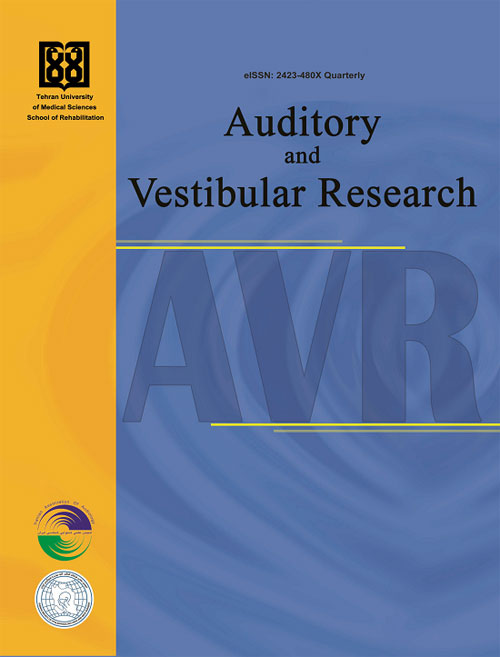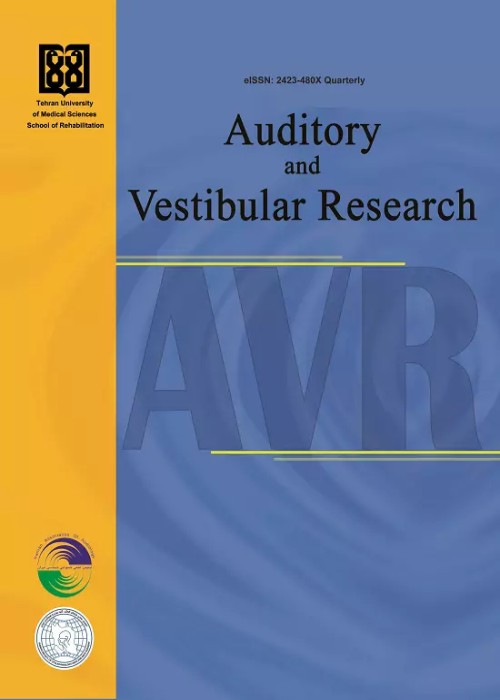فهرست مطالب

Auditory and Vestibular Research
Volume:28 Issue: 4, Autumn 2019
- تاریخ انتشار: 1398/04/29
- تعداد عناوین: 8
-
-
Pages 204-216Background and AimTinnitus is a perception of sound in ears or head in the absence of any external stimuli. Despite its high prevalence in various age groups, tinnitus has still no effective treatment because its physiological and pathological mechanisms have remained unknown. Since the study of cellular-molecular mechanisms of tinnitus production and stability in human is not feasible, animal models have been used to shed some light on tinnitus induction and propagation mechanisms. This study reviewed some of these research studies. The present review article is based on articles published during 1967-2018 in which keywords such as “salicylate,” “noise,” “tinnitus in the animal model,” and “tinnitus mechanism” were used. These articles were searched in databases such as Science Direct, Google Scholar, PubMed, and Scopus.Recent FindingsDespite differences in the mechanisms of tinnitus induction, the structural changes initiated from the cochlea and continued to cortex reflect the extent of the affected regions in the creation, development, and preservation of tinnitus.ConclusionAnimal models (exposed to noise or ototoxic drugs such as salicylate) are ideal tools for studying tinnitus and understanding the details of its propagation and unknown mecha nisms.Keywords: Tinnitus, animal models of tinnitus, salicylate, noise
-
Pages 217-220Background and AimAuditory steady-state response (ASSR) has widespread usage in the clinical hearing assessment of infants and young children. The present study evaluated the effect of restricting maximum possible intensity to 100 dB HL on ASSR thresholds.MethodsThis retrospective study was conducted in multiple audiology centers. ASSR thre sholds with restricted settings were evaluated in 58 infants (116 ears). They had absent otoacoustic emissions and click-evoked auditory brainstem response waveforms and bilateral severe to profound hearing loss in behavioral evaluations.ResultsASSR thresholds were absent in 28 %, 25%, 60 %, and 70 % of ears in 500, 1000, 2000, and 4000 Hz, respectively. The mean value of remained thresholds was approximately 90−95 dB HL.ConclusionRestricted ASSR settings are prevalent; however, they fail to provide extensive additional information about hearing sensitivity. Thus, manufacturers are suggested to improve ASSR setting and transducers and resolve the intensity restrictions. ASSR settings should be able to test auditory thresholds to level of 120 dB HL.Keywords: : Auditory steady-state response, infants, profound hearing loss, restrictedintensity setting
-
Pages 221-227Background and AimDichotic listening disorders occur secondary to interhemispheric transfer dysfunction. Central processing tests such as staggered spondaic words (SSW) and dichotic digits test (DDT) are recommended for the evaluation of dichotic listening in patients with multiple sclerosis (MS). The present study aimed to evaluate dichotic listening in subjects with MS by SSW and DDT.MethodsThis cross-sectional study was conducted on 45 patients with MS, including 20 males (mean ± SD age: 35.95 ± 5.73 y) and 25 females (mean ± SD age: 37.40 ± 6.1 y) and their data were collected by the Persian version of SSW (P-SSW) and DDT. The results compared to 45 normal subjects age- and gender-matched as the control group.ResultsIn patients with MS, P-SSW quantitative and qualitative errors (except for Sm2 and reversals), errors were significantly more than the control group (p ≤ 0.001). Right and left ear scores in DDT for the patients with MS were significantly lower, and right ear advantage was significantly higher than that in the control group (p ≤ 0.001). The results also showed a significant correlation between the test of P-SSW and DDT in the left ear.ConclusionThe present study showed that patients with MS have lower performance in dichotic listening and binaural processing than normal peers. Identification of binaural processing deficit in patients with MS may lead to early rehabilitation and improving their function by facilitating auditory processing.Keywords: : Speech perception, auditoryprocessing, dichotic listening, multiplesclerosis, binaural hearing
-
Pages 228-234Background and AimThe etiopathogenesis of sensorineural hearing loss (SNHL) is an essential contributing factor to its morbidity, which cannot be explained entirely so far. The current study aimed to determine the oxidative stress (OS) status by comparing the total antioxidant status (TAS), total oxidant status (TOS) and oxidative stress index (OSI) values in patients with pediatric prelingual profound SNHL. We also evaluated the correlation between OS parameters and audiological test results.MethodsThe study included 25 participants (9 females; age range: 6‒34 months) diagnosed with pediatric prelingual profound SNHL and 25 healthy subjects (10 females; age range: 9‒28 months). Their TAS, TOS, and OSI levels were measured in the plasma of both groups. We evaluated the correlation between OS parameters and audiological test results in the patient group.ResultsWe found significantly higher serum TOS levels and OSI values in the patient group (mean ± SD of TOS: 16.08 ± 1.88 μmol H2O2 eq/L, p < 0.001; mean ± SD of OSI: 1.71 ± 0.48 arbitrary units, p < 0.001), compared to the controls. Moreover, we found lower serum TAS levels in the patient group (mean ± SD of TAS: 0.99 ± 0.20 mmol Trolox eq/L), compared to the controls. There was a strong correlation between OS parameters and audiological test results of the patient group.ConclusionWe detected significantly higher TOS, OSI, and lower TAS levels in pediatric patients with SNHL, compared to the healthy subjects. The obtained data indicated that pediatric SNHL is under OS influence.Keywords: Sensorineural, hearing loss, oxidative stress, total oxidant status, totalantioxidant status
-
Pages 235-241Background and AimThe current study aimed to investigate the validity and reliability of the Persian version of the Infant-Toddler Meaningful Auditory Integration Scale (IT-MAIS) questionnaire. Because cochlear implantation is done today at younger ages, the use of a suitable questionnaire is necessary to evaluate auditory skills and follow up the rehabilitation progress.MethodsIT-MAIS was translated according to the International Quality of Life Assessment (IQOLA) translation protocol. The content validity was performed using Lawshe method with the participation of 10 expert professionals. The questionnaire was completed for 34 parents of cochlear-implanted children before initial programming of the device, two weeks after the reh abilitation program, and finally three months later. The intraclass correlation coefficient was calculated for test-retest reliability for each IT-MAIS subscale. The internal consistency reli ability was analyzed using the Cronbach α coefficient.ResultsThe content validity ratio for all items was above 0.79, and the content validity index was obtained to be higher than 0.96. The Cronbach α for the entire questionnaire was 0.74, and for different sections of it was obtained as 0.63‒0.67. A significant difference was observed between the total score of the questionnaire before and after the rehabilitation pro gram and its sub-items (p < 0.001).ConclusionThe Persian version of the questionnaire of IT-MAIS is a valid instrument in terms of translation quality as well as reliability and validity for assessing cochlear implant user children who are younger than three years.Keywords: Reliability, validity, meaningfulauditory integration scale, cochlear-implantedchildren
-
Pages 242-248Background and AimVibration is a method for stimulating the vestibular system. This method can unmask asymmetry between two vestibular systems (such as unilateral peripheral vestibular disorders). The occurrence of vibration-induced nystagmus (VIN) in healthy subjects can affect the diagnosis of patients with unilateral peripheral vestibular disorders. Thus, the evaluation of VIN in healthy subjects is critical to help the diagnosis of unilateral peripheral vestibular disorders.MethodsThis study was carried out on 72 healthy subjects (mean ± SD age: 27.12 ± 4.97 years) in the Auditory and Balance Clinic of Rofeideh Rehabilitation Hospital. Vibration sti mulation with a frequency of 30 and 100 Hz was used on mastoid and posterior cervical muscles (PCMs) and simultaneously eye movements were recorded and analyzed using videonystagmography.ResultsThe mastoid vibration with a frequency of 30 and 100 Hz, respectively produced VIN in 16.67 % and 27.78 % of subjects and VIN observed in PCMs vibration with a frequency of 30 and 100 Hz in 4.17 % and 9.72 % of the subjects.ConclusionThe occurrence of VIN in healthy subjects was more probable with mastoid vibration in 100 Hz. In this study, VIN was predominantly horizontal, its direction was toward the stimulated side, and its slow phase velocity was lower than 5 deg/s. These criteria could be used for differentiation between normal and abnormal subjects.Keywords: Vibration-induced nystagmus, vestibular vibration, mastoid, posterior cervicalmuscle, videonystagmography
-
Pages 249-255Background and AimTime compressed speech test is one of the most useful monaural tests for evaluation of central auditory processing disorder. For developing the time compressed sentences test, the compression rate of the sentences must be set so that the average speech comprehension score is about 90% in normal individuals and can challenge central auditory processing system sufficiently so subjects with auditory processing disorders could be identified. Therefore, the aim of the present study was finding the appropriate compression rate for developing compressed sentences test in Persian.MethodInitially, two 10-sentence lists were prepared based on the experts’ opinion and were compressed by the amount of 60, 65, 70, 75 and 80% using Praat software. Compressed sentences were tested on twelve 18–25 year-old normal individuals and the speech comprehension score in different compression rates was compared and the compression rate in which the average score was approximately 90% was reported as an appropriate compression rate for developing time compressed sentences test in Persian.Results70% compression rate was able to create an average score of 95.27% (± 3.31) and 93.6% (± 7.17) in the right and left ear, respectively.ConclusionResults showed that the compre ssion rate of 70% was appropriate rate for developing the test in the Persian language.Keywords: Central auditory nervous system, psychometric properties, central auditoryperceptual disorder
-
Pages 256-264Background and AimChildren's hearing loss affects not only their speech and language development but also their mothers’ mental health. This study aimed to determine the effect of acceptance and commitment therapy (ACT) on the intolerance of uncertainty and experiential avoidance of mothers with hearing-impaired or deaf children.MethodsThis is a quasi-experimental study with the pretest-posttest design with a control group. The study population comprised all mothers of hearing-impaired or deaf children (2−6 years old) in Tabriz City, Iran. Using a purposive sampling method, 32 mothers of hearing-impaired or deaf children were selected and then randomly assigned to control and experimental groups (each group, 16 subjects). The experimental group was treated with ACT in 8 sessions of 1.5 hours long in two weeks. The study data were collected by the Acceptance and Action Questionnaire-II (AAQ-II) and Intolerance of Uncertainty Scale (IUS).ResultsThe results showed that ACT significantly increased scores on the AAQ-II and IUS in the experimental group compared to the control group (p < 0.001).ConclusionACT might be an efficient way to decrease intolerance of uncertainty and avoidance of experience in the mothers of hearing-impaired and deaf children. Also, therapists can use this approach for improving the intolerance of uncertainty and experiential avoidance in mothers of hearing-impaired or deaf children in rehabilitation centers.Keywords: Hearing impairment, experientialavoidance, intolerance of uncertainty, acceptance, commitment therapy


